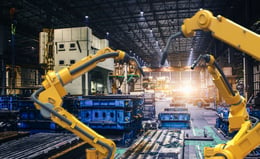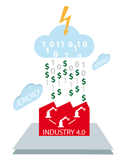5 Tips for Increasing Production Visibility
Brian Hoey - June 20, 2019

 Imagine for a second that your factory is essentially a black box. Materials go in, and finished products come out, but what happens in between is fundamentally mysterious. What challenges would this present from an advanced planning and scheduling perspective? Sure, in this environment you can get a small sense of the correlation between raw material volumes and finished product volumes—you might even be able to gain a sense of which raw materials loosely correspond to which products. But surely there’s a lot of information you’d really like to have: how do different products differ in resource usage? What are the most common causes of delays and disruptions? How can you more effectively align your capacity with emerging demand levels?
Imagine for a second that your factory is essentially a black box. Materials go in, and finished products come out, but what happens in between is fundamentally mysterious. What challenges would this present from an advanced planning and scheduling perspective? Sure, in this environment you can get a small sense of the correlation between raw material volumes and finished product volumes—you might even be able to gain a sense of which raw materials loosely correspond to which products. But surely there’s a lot of information you’d really like to have: how do different products differ in resource usage? What are the most common causes of delays and disruptions? How can you more effectively align your capacity with emerging demand levels?
Naturally, there would be no way to get answers to these questions—and thus no way to optimize your planning workflows—without shedding some light on the manufacturing black box. Even if you were able to gain physical entry and walk up and down the factory floor, you might still be in the dark about a lot of issues. This begs the question: what information do you need in order to optimally plan production processes, and how can planners attain that information in a timely way?
1. Set Proactive Benchmarks
When we ask how planners can gain the information they need to create optimal production flows, the unspoken answer is increased visibility. If you can see which processes require which resources, where those resources come from, how much they cost and how much you have in reserve, you can begin to match your processes to customer orders more effectively. Rather than continuing on a path blindly, you can compare your raw material inventory to a bill of materials for each order as it comes in, earmark stock for production as needed, and place orders with your suppliers accordingly—just to provide a representative example. In order to achieve the level of visibility required for this, you first need to understand your current capacity levels for different production ratios and the bill of materials for each production flow. Not only do you need to understand them, you also need to determine what your ideal capacity levels should be. Why? So that you can you can direct your attempts at increased visibility at a specific goal. Your initial estimates will no doubt change over time, but the journey to achieve these benchmarks will help clarify areas for improvement.
2. Root Out Data Silos
Here you might be asking, “what do you mean by clarify?” Simply put, we mean that once you have a goal it will become increasingly obvious what data sources you need in order to achieve those goals—thus giving you a clear directive on your path to end-to-end (E2E) visibility. Anywhere that you identify a need for information and a corresponding inability to access that information (i.e. an information silo), your first task is take steps to eliminate that silo. This might take a number of different forms, from eliminating Shadow IT (i.e. software solutions that aren’t sanctioned by—and thus don’t integrate with—leadership-approved systems) to digitizing processes that might still be performed manually. Naturally, this will vary a lot from one organization to another, but the goal is to reach a point where any given piece of information, from exact customer order requirements to machine usage logs, can be accessed by key stakeholders.
3. Create Digital Twins
On some level, information equals visibility. If you eliminate Shadow IT and integrate different departments through a connected software solution, you almost certainly have a higher level of visibility than most manufacturing businesses. At the same time, from an advanced planning and scheduling perspective, data is only as valuable as its ability to help inform your decisions. From this perspective, the types of information we’ve been talking about can be instructive, but why not take it one step further? If you create a digital representation of your factory (also known as a digital twin), complete with data integration from multiple sources, you can simulate the working of your factory digitally. In this way, you can not only determine with increased certainty your ability to meet orders in a timely fashion, but also envision the effects of any proposed changes. In this way, you gain visibility not just into your value chain as it is, but as it could be—i.e. you can visualize not just individual materials or processes, but the full spectrum of ramifications for those materials and processes.
4. Utilize IoT Sensors
Speaking of integrating data streams: once you’ve got the infrastructure to make use of them, internet of things (IoT) devices and other smart sensors can help add real-time capabilities to your production planning. By implementing these types of devices, not only can you gain data and reporting from all elements of your value chain, you can actually monitor that value chain live via a digital interface. Again, rather than setting a plan in motion and hoping for the best, you can monitor your production lines for potential hiccups as they unfold, taking proactive measures to prevent any would-be disruptions before they happen while simultaneously positioning yourself to adjust your plans on the fly if need be.
5. Strive for Supply Chain Integration
Above, we talked a little bit about integrating each touchpoint on your organization’s value chain through a connected IT solution. The next step, if you really want to maximize visibility, is to connect your suppliers and logistics providers as well. This is a key step on the road to true E2E supply chain visibility. Think about it: when your factory was simply a black box that took in materials and spat out finished goods, it was difficult to optimize your advanced planning and scheduling. Why shouldn’t the same logic apply further up and downstream in the supply chain? If you can better understand what your logistics providers are doing, you can respond more effectively to your customer’s delivery needs and pivot more quickly when things go wrong. By the same token, data integration with your sourcing partners can help you plan out your material usage more carefully, and thus more cost-effectively. At the end of the day, this is really what visibility is all about: gaining new insights in order to drive cost savings and boost revenue.
LATEST POSTS
- Understand Circular Economy in The Manufacturing Industry
- How Can Industry 4.0 IT Integration Be Achieved Smoothly?
- The Significance of Order Sequencing in Discrete Manufacturing
- How to improve your Supply Chain Management: The Power of Control Towers
- Optimizing Human Resource Scheduling in Manufacturing: A Technological Approach



